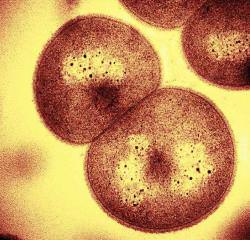You know the cliche, wherever we find water here on Earth, we find life. But what if the environment is really hostile? So hostile that any living creature would almost never see water. And even when there was water, they were constantly being blasted with radiation. Amazingly, there’s a microbe out there, Deinococcus geothermalis, that can handle some of the harshest environments on the planet – favoured habitats include nuclear power plants. Scientists once suspected that microbes like this might have evolved on Mars. Nope, they’re homegrown.
Of all the different strains of bacteria on Earth, those in the genus Deinococcus are a hardy bunch. They’re extremely resistant to ionizing radiation, they laugh at ultraviolet light, extreme, heat, cold and they don’t mind being completely dried out for long periods. Bathed in acid? Boring.
D. geothermalis is actually a cousin of another microbe called Deinococcus radiodurans. D. radiodurans is capable of withstanding 500 times the radiation that will kill a human – with no loss of viability. The Guiness Book of World records calls D. radiodurans the toughest bacteria in the world, and some scientists have proposed that it actually evolved on Mars and somehow journeyed to Earth.
Researchers have recently sequenced the bacteria’s cousin, D. geothermalis’ entire genome sequence, providing some valuable clues into how a microbe can be so tough, and how they two are related (no Martian explanation necessary).
Their paper describing the results of their sequencing efforts, entitled Deinococcus geothermalis: The Pool of Extreme Radiation Resistance Genes Shrinks will be published in the September 26th issue of the journal Public Library of Science.
The microbe was first discovered in a hot pool at the Termi di Agnano, in Naples, Italy. Other scientists have turned it up in other nasty locations, such as industrial paper machine water, deep ocean subsurface environments, and subterranean hot springs in Iceland.
While working with the microbe, the researchers noted, “the extraordinary survival of Deinococcus bacteria following irradiation has also given rise to some rather whimsical descriptions of their derivation, including that they evolved on Mars.”
In fact, the US Department of Energy is considering D. geothermalis as a possible solution to break down radioactive waste. Which would be good, since it’s often a pest; adhering to the surface of steel, and causing problems in nuclear power plants.
Currently, scientists have no idea why bacteria like D. geothermalis are so hardy to radiation. They’re just as susceptible to normal bacteria to have their DNA broken up by radiation, but they use some kind of efficient repair mechanism to fix the damage quickly.
The big surprise with this research is that it overturns previously held theories about how D. radiodurans protects itself. The two strains of bacteria are both extremely resistant to radiation, and yet D. geothermalis lacks the genes that scientists thought D. radiodurans was using. By comparing genome sequences between the two strains, the researchers were able to narrow down the genes which are likely contributing to the microbes’ tolerance.
This research also overturns the intriguing possibility that D. radiodurans comes from Mars; evolving on the Cosmic Ray blasted surface of the Red Planet. These two strains have enough in common, with traceable evolutionary steps, that the researchers can see how they evolved right here on Earth.
Here’s Dr. Michael J. Daly, an associate professor at the Uniformed Services University of the Health Sciences in Bethesda, “the thermophile Deinococcus geothermalis is an excellent organism in which to consider the potential for survival and biological evolution beyond its planet of origin, as well as the ability of life to survive extremely long periods of metabolic dormancy in high-radiation environments. The current work reinforces the notion that resistance to radiation and desiccation readily evolved on Earth, and that the underlying resistance systems are based on a universal set of repair genes. The work underscores the vulnerability of potential life-inhabiting environments on Mars to contamination by human exploration; and how the efficiency of ordinary DNA repair proteins could be increased, which might be important to astronauts. The growing awareness that there is hardly a habitat on Earth not harboring life is now changing our consensus of consequences for possible life on Mars.”
Sorry Mars, go evolve your own microbes.
Original Source: PLOS Journal article


Information provided by you on Deinococcus radiodurans is highly valuable. It is of great interest .I would be greatful to you if you kindly provide me more research articles on D.radiodurans..